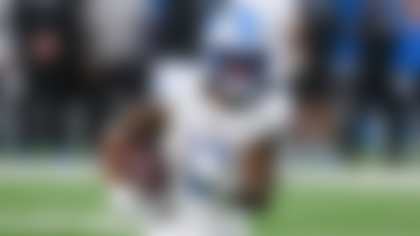With the start of the 2024 NFL regular season just around the corner, NFL Media Draft Analyst Chad Reuter projects the best- and worst-case scenarios for the 13 defensive rookies he expects to make the biggest impact in 2024.
Projected statistics are based on the recent production of first-year players with similar talent in similar circumstances.

Drafted: Round 1, No. 15 overall
Best-case scenario: Latu seizes the opportunity provided by Samson Ebukam's Achilles tear, making a name for himself as a starter alongside Kwity Paye. His strength as a pass rusher and run defender propels him to the front of the Defensive Rookie of the Year conversation by the end of the season.
Worst-case scenario: If NFL tackles are able to neutralize Latu's power pass-rush moves and it takes him some time to develop effective counters, he might not rack up a ton of sacks in Year 1. The thing that could really slow Latu down as a rookie, however, would be an injury, which hopefully does not occur. Anyone who followed Latu in college (when he briefly was medically retired due to a neck injury) knows that the health history was a part of his pre-draft analysis. Clearly, it wasn't a red flag for the Colts, who made him the first defensive player selected. And understandably so: I like his potential in 2024.
Projected stats: 35 tackles, 7 tackles for loss, 5 sacks.

Drafted: Round 1, No. 16 overall
Best-case scenario: Seahawks coaches name Murphy the starting one-technique over Jarran Reed because of his explosiveness off the snap and excellent leverage in the run game. He also gets snaps at three-technique when Reed plays on the center to keep Dre'Mont Jones and Leonard Williams fresh.
Worst-case scenario: Reed's experience keeps him in the starting lineup with Jones and Williams, relegating Murphy (and veteran Johnathan Hankins) to backup duty. Murphy's lack of height (he measures 6-foot-1/2 inches) and length (32 7/8-inch arms) make it more difficult to consistently fend off NFL offensive linemen.
Projected stats: 50 tackles, 8 tackles for loss, 5 sacks.

Drafted: Round 1, No. 17 overall
Best-case scenario: The Vikings signed veterans Jonathan Greenard and Andrew Van Ginkel this offseason, but Turner still earns starter's snaps. He sees plenty of opportunities, proving himself a strong run defender and using his speed/long-arm move to win against NFL tackles.
Worst-case scenario: Van Ginkel gets the majority of snaps across from Greenard because of his experience, leaving Turner to serve primarily in a pass-rushing role. And his lean build could get him in trouble against larger, stronger offensive linemen.
Projected stats: 35 tackles, 8 tackles for loss, 6 sacks.

Drafted: Round 1, No. 19 overall
Best-case scenario: Verse uses his power and relentless style of play to get into the faces of quarterbacks and hold the edge against the run. Despite the emergence of Byron Young and Kobie Turner as rookies last season, the Rams' pass rush was on the mediocre side, with the team ranking 16th in pressure rate and tied for 23rd in total sacks. Verse teams with Young off the edge to take the unit to the next level.
Worst-case scenario: Verse is unable to beat better tackles, providing solid play but lacking the elite size, length and speed to be a true difference-maker in Year 1.
Projected stats: 60 tackles, 9 tackles for loss, 7 sacks.

Drafted: Round 1, No. 21 overall
Best-case scenario: With Jaelan Phillips (Achilles tear) and Bradley Chubb (ACL tear) working their way back from serious injuries (Phillips only recently returned to the field, while Chubb is still on the PUP list), Robinson is given early playing time -- and thrives. He overcomes concerns about his relative lack of productivity at the college level (11.5 sacks in 35 career games), using his quick get-off to beat his man around the edge and getting free lanes on twists with inside linemen.
Worst-case scenario: Robinson's smallish frame (6-foot-2 7/8, 254 pounds; 32 1/2-inch arms) puts him at a disadvantage against massive tackles. If he's unable to perfect counter moves to his speed rush and gets overwhelmed at the point of attack playing the run, Robinson might get stuck coming off the bench.
Projected stats: 30 tackles, 5 tackles for loss, 4 sacks.

Drafted: Round 1, No. 22 overall
Best-case scenario: Mitchell's competitive nature and elite athleticism help him earn a starting job. He did not play inside a ton at Toledo, but he's been excellent there in the preseason. If fellow rookie Cooper DeJean gets fully healthy and returns to play the slot, Mitchell moves outside and stands up to challenges from opponents avoiding Darius Slay on the other side.
Worst-case scenario: Mitchell goes through the typical rookie learning curve when dealing with the savvy route-running and physicality of veteran receivers. DeJean wins the nickel job and Mitchell struggles against established wideouts outside early in the season, allowing Kelee Ringo, Eli Ricks or Josh Jobe to get playing time.
Projected stats: 30 tackles, 1 interception, 9 pass breakups.

Drafted: Round 1, No. 24 overall
Best-case scenario: Emmanuel Moseley's pectoral injury has already opened the door for Arnold to lock up the starting role across from Carlton Davis. Arnold's exceptional short-area quickness, physicality and ability to find the ball in the air give him a chance to be a true playmaker -- not just a starter.
Worst-case scenario: Quarterbacks and receivers test Arnold’s average deep speed, making big gains downfield. Talented second-round pick Ennis Rakestraw Jr. begins to eat into Arnold's reps.
Projected stats: 50 tackles, 1 interception, 11 pass breakups.

Drafted: Round 2, No. 38 overall
Best-case scenario: Sweat has impressed during the preseason with his power and underappreciated quickness off the snap. That carries over into the regular season. He gets into the backfield more regularly than some were expecting given his 6-foot-4, 335-pound frame, and he eats double-teams to free up fellow defensive lineman Jeffery Simmons, linebacker Kenneth Murray and fourth-round pick Cedric Gray, a potential starting 'backer.
Worst-case scenario: The grind of the season wears on the big defensive tackle. If he's not in top condition, his snaps will be limited and he might run into the rookie wall earlier than desired.
Projected stats: 35 tackles, 5 tackles for loss, 1 sack.

Drafted: Round 2, No. 42 overall
Best-case scenario: "The Locksmith" lives up to his nickname, playing with physicality to stay in-phase down the sideline and using his short-area quickness/toughness to bring down receivers immediately -- if they manage to secure a pass thrown in their direction. Lassiter racks up a ton of pass breakups with opponents avoiding Derek Stingley Jr. on the other side.
Worst-case scenario: The ankle injury that has limited Lassiter this summer lingers into the fall. He loses some downfield challenges early in the season due to his average long speed. Former first-rounders C.J. Henderson or Jeff Okudah, a pair of cut candidates in Houston, rebound from struggles at their previous stops to take over the outside starting spot opposite Stingley.
Projected stats: 45 tackles, 1 interception, 12 pass breakups.

Drafted: Round 2, No. 45 overall
Best-case scenario: Cooper proves comfortable enough with the Packers' new defensive scheme to grab the starting job from the jump. The size and athleticism that made him a second-round pick allows him to track down ball-carriers in the backfield and on the sideline.
Worst-case scenario: The hip injury suffered during an early August practice limits his playing time. Veteran linebackers Isaiah McDuffie and Eric Wilson earn the coaches' trust and become Green Bay’s top choices to play beside Quay Walker at the second level.
Projected stats: 65 tackles, 4 tackles for loss, 2 sacks, 3 pass breakups.

Drafted: Round 2, No. 56 overall
Best-case scenario: Kneeland beats out veteran players for reps, helping replace the injured Sam Williams (knee). Kneeland's power and hustle off the edge earns him second-effort sacks, and his leverage playing against the run makes him an asset in the new Cowboys defense.
Worst-case scenario: After posting mediocre sack production in college (13 in 38 games), the issue follows him into the NFL, as he's unable to win outside with initial quickness or a counter rush move. Veteran players step up in Williams' absence, keeping Kneeland from making a major impact.
Projected stats: 25 tackles, 6 tackles for loss, 2 sacks.

Drafted: Round 2, No. 58 overall
Best-case scenario: Bullard and free-agent acquisition Xavier McKinney form one of the most versatile safety duos in the league, both playing in the box, deep and in coverage with equal aplomb. The former Georgia Bulldog continues his penchant for producing big plays in critical situations, creating turnovers and making key open-field stops late in games.
Worst-case scenario: Larger slot receivers and tight ends make plays over Bullard, who measures 5-foot-10. Fourth-round pick Evan Williams ends up earning significant snaps.
Projected stats: 70 tackles, 4 tackles for loss, 3 interceptions, 8 pass breakups.

Drafted: Round 2, No. 60 overall
Best-case scenario: Bishop displays the football IQ to go with his top-notch athleticism, stepping in for free agent Micah Hyde at free safety. He stops ball-carriers securely in space and covers a ton of ground in the back end to stop big plays from becoming scores.
Worst-case scenario: His excellent NFL Scouting Combine workout does not translate to the field in his first year, and he struggles to bring down stronger NFL ball-carriers, clearing the way for veteran safeties on the roster to take snaps from him.
Projected stats: 50 tackles, 2 tackles for loss, 1 interception, 3 pass breakups.
























